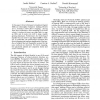Free Online Productivity Tools
i2Speak
i2Symbol
i2OCR
iTex2Img
iWeb2Print
iWeb2Shot
i2Type
iPdf2Split
iPdf2Merge
i2Bopomofo
i2Arabic
i2Style
i2Image
i2PDF
iLatex2Rtf
Sci2ools
VLDB
1995
ACM
1995
ACM
A Performance Evaluation of OID Mapping Techniques
In this paper, three techniques to implement logical OIDs are thoroughly evaluated: hashing, B-trees and a technique called direct mapping. Among these three techniques, direct mapping is the most robust; it induces at most one page fault to map an OID, and it scales very well to large, rapidly growing databases. Furthermore, the clustering of handles that are used to map logical OIDs is studied. In particular, the performance of B-trees and direct mapping can improve significantly if the handles of objects that are frequently accessed by the same methods are clustered. For direct mapping, two placement policies arc compared: linear and matrix clustering.
B-trees | Database | Direct Mapping | Logical Oids | VLDB 1995 |
| Added | 26 Aug 2010 |
| Updated | 26 Aug 2010 |
| Type | Conference |
| Year | 1995 |
| Where | VLDB |
| Authors | André Eickler, Carsten Andreas Gerlhof, Donald Kossmann |
Comments (0)

